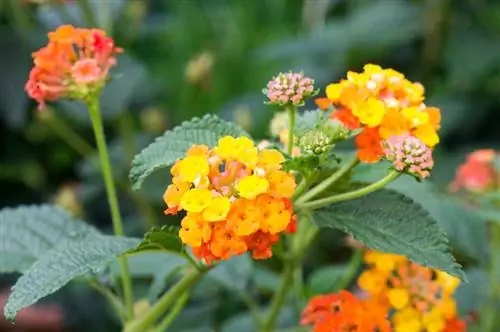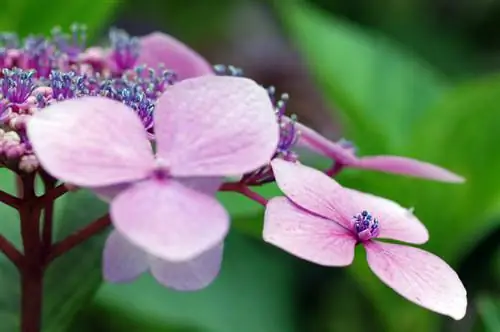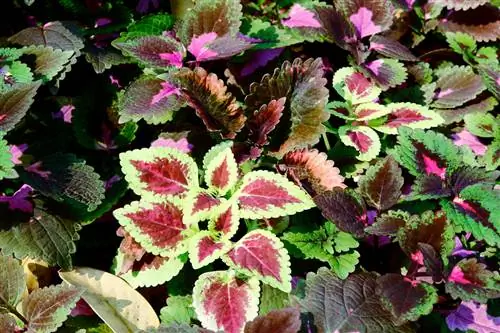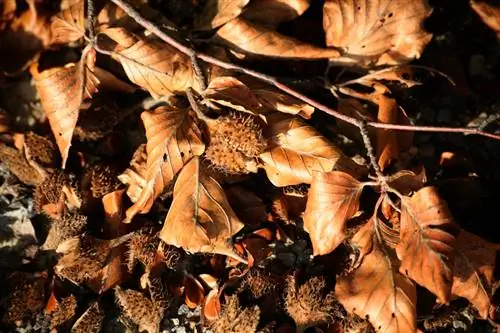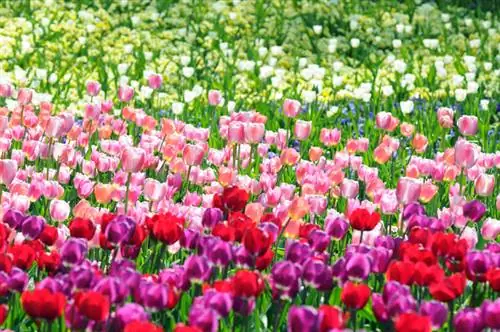- Author admin [email protected].
- Public 2023-12-25 17:45.
- Last modified 2025-01-23 11:20.
They are a floral hit in the summer garden and on the balcony. Lantanas captivate us when they seem to change the color of their exotic flowers at will. The following answers to frequently asked questions explain in detail how you can also enjoy the graceful play of colors.
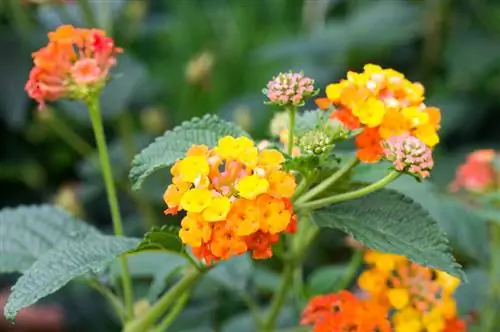
How do you properly care for a lantana?
Lantern lantana requires a sunny location and well-drained, nutrient-rich soil. Regular watering with lime-free water, weekly fertilizing from March to September and removing wilted flowers promote a long flowering period from May to October.
Planting lantana correctly
Plant a young lantana in a sufficiently large pot or flower box in mid/late May so that no repotting is necessary during the year. Our tip: Place varieties for the bed in a pot that you sink into the ground. You take this out in the fall to overwinter the ornamental tree frost-free. Only fill in a structurally stable container plant soil, permeable and nutrient-rich, once you have inserted clay shards over the bottom opening as drainage. Meanwhile, the still potted root ball is soaked with soft water until no more air bubbles appear. Maintain the previous planting depth when you place the now potted Lantana camara in the ground. A well-measured sip of lime-free water rounds off the planting process professionally.read more
Care tips
You will experience a lantana in its floral best when the distinctive flowering tree is given this care program:
- Keep the substrate continuously moist with lime-free water
- Watere twice a day on hot summer days
- Fertilize liquid weekly from March to September
- Cut off wilted flowers as soon as possible for a long flowering period
- Carry out all maintenance work with protective gloves
In autumn, cut off the remaining flowers and any berries to put away the ornamental tree including the pot and flower box. Overwintering is successful in a bright location at temperatures between 10 and 15 degrees Celsius. Please water less and do not apply fertilizer from October to February. In February/March, cut back the tropical flowering trees by up to 75 percent and repot the plant into fresh substrate.read more
Which location is suitable?
Lanta roses only develop their picturesque play of colors in a sunny and warm location. If the daily exposure to sunlight is more than 4 hours, you can look forward to a never-ending flowering period from spring until well into autumn. The exotic ornamental shrubs only take their place in the open air when temperatures permanently exceed 15 degrees.
The correct planting distance
When properly measuring the planting distance, the special growth behavior of the lantana comes into focus. The majority of Lantana camara from the popular hybrid series Bandana, Esperanta or Tropic thrive more than twice as wide as they are tall. The beauties of the Luxor series even triple their height in width. With a planting distance of 40-50 cm you are exactly right in the bed. For cultivation in balcony boxes, reduce this value by 5-8 cm.
What soil does the plant need?
A noble flowering tree should not be confronted with cheap potting soil from a discount store. So that the lantana can display its magical play of colors to perfection, a high-quality potted plant soil with a pH value of 6.0 to 6.5 should be shortlisted. The ED73 Classic standard soil with natural clay and white peat has proven itself well. For cultivation in large pots, the focus is on the CL Perl Classic potting substrate, which is structurally stable and has a high air capacity for the roots. The specialist retailer Gepac B&B offers premium quality soil, with high-quality components and extra iron fertilizer to prevent leaf chlorosis.
What is the best time to plant?
The lantana found its way to us from the sunny, warm tropical regions of the world. The ornamental tree reacts correspondingly sensitively to cold. The time window for planting only opens when the mercury column permanently exceeds the 15 degree mark. In Central Europe this will not be the case until mid/end of May at the earliest.
When is flowering time?
The lantana lives up to its reputation as a permanent bloomer with a flowering period from May to October. In order to maintain this flower festival over a long period of time, the tree needs your gardening support. Cut out the withered flowers regularly, as the next buds are already waiting underneath. Please use sharp, disinfected scissors as the shoots become woody over the course of the season.read more
Cut wandelroses correctly
During the summer growth and flowering period, secateurs are only used when you cut off the withered flowers. Otherwise, the lantana wants to be left alone. The only exception is cutting the most beautiful flower stems for the vase or bouquet. To do this, cut shoots with flowers that have just opened for a long shelf life. The flowering tree receives the central shape and maintenance pruning in February/March, when winter dormancy is coming to an end. At this time, cut off the shoots by up to two thirds. The more courageously you work, the more lush the next flower will be, as the verbena plant always blooms on this year's shoots. When making the cut, please ensure that you place the scissors a few millimeters above an outward-facing, sleeping eye. You can recognize a sleeping eye as a slight thickening under the bark.read more
Watering lantana roses
Do not let the substrate dry out. The sunnier the location, the thirstier the lantana is. However, only water when the surface of the soil has dried out so that waterlogging cannot form. On hot summer days, it is not uncommon for the plant to be watered early in the morning and again in the evening. Please use mostly soft water, like the tropical beauty knows from her homeland.
Fertilize lantana properly
You will fulfill your desire for a high supply of nutrients if you fertilize the lantana with liquid liquid weekly from March to September. Alternatively, apply a slow-release fertilizer in stick or cone form in March, May and July. In October, stop giving fertilizer so that the plant matures before winter dormancy.read more
Diseases
It is the high water requirement that makes the lantana susceptible to botrytis, the gray mold that is widespread in the garden. Plants that have been weakened due to neglected care are particularly vulnerable to fungal spores. If a gray patch of mold spreads on the leaves and shoots, there is an urgent need for action. Immediately cut off all affected parts of the plant and dispose of them with household waste. Put all cultivation conditions to the test in order to initiate possible improvements. An effective control agent has not yet been developed.read more
Pests
The lantana is often plagued by penetrating whiteflies. Sticky traps have proven to be effective against these pests. You hang these glue-coated boards in the infected plants. Get rid of the annoying aphids with the classic soft soap solution.
Wintering
Successful overwintering is less delicate than its tropical origins suggest. Put away your lantana in good time when temperatures fall below 15 degrees Celsius in autumn. Beforehand, just cut off the withered flowers and any fruits, as the best date for the main cut is at the end of winter dormancy. This is how the evergreen trees get through the winter he althy and happy:
- Set up in a bright, not full sunny window seat
- Temperatures between 10 and 15 degrees Celsius
- The more leaves fall, the less watering takes place
- Do not fertilize from October to February
In February/March, cut back the lantana vigorously and repot it in fresh substrate. Then gradually accustom the stressed tree to sunny lighting conditions and higher temperatures before it takes its place in the summer garden from mid/end of May.read more
Propagate lantana roses
With the help of half-woody head cuttings, you can grow more lantana in no time. To do this, cut off non-flowering shoots that are 10-12 cm long in summer to defoliate the lower half. Follow these steps:
- Fill small pots with peat sand or potting soil
- Insert one cutting two thirds at a time and water it
- Put a transparent bag over the top to create a warm, humid microclimate
- Set up in a partially shaded, warm and wind-protected location
Afterwards, keep the substrate constantly slightly moist with soft water. To prevent rot from forming, ventilate the cover several times a day. If a cutting sprouts fresh, rooting is successful and the cap can be removed. Care for your young ones throughout the winter in a bright, cool window seat, like their adult counterparts. Until next spring you will have vital and strong young plants in your hands.read more
Is lantana poisonous?
All members of the Lantana genus are poisonous in all parts. Unfortunately, the ever so popular Lantana camara tops the toxic ranking. The poison content is primarily concentrated in the berries. Intentional or unintentional consumption results in dramatic symptoms similar to deadly nightshade poisoning. The ornamental tree has no place in the family garden or within reach of pets. As a gardener, please take this into account by wearing gloves and long-sleeved clothing during all planting and care work.read more
Beautiful varieties
- Cherry Sunrise: Bicolor premium variety of the large-flowered Bandana series with orange and pink flowers; 60-150cm
- Calipo Gold: Bushy, tightly upright Lantana variety with golden yellow flowers for pots and flower boxes; 40cm
- Esperanta Pink: Magnificent ornamental tree with pink-red flowers and an extra long flowering period from May to October; 35-40cm
- Lucky Peach: The lantana spreads a Mediterranean flair with changing peach nuances; 35-40cm
- Tutti Frutti: Floral quick-change artist with flowers in orange, pink, violet and yellow; 50-150cm
- Bandana Red: Summery flower dream in bright red tones, blooming profusely in beds and pots; 50-150cm
- Lucky Lemon Cream: The lantana from the Lucky series produces a cream-yellow flower dress; 35-40cm
- Luxor Yellow: The short-growing variety impresses with its splendid yellow flowers and broadly bushy habit: 20 cm high

